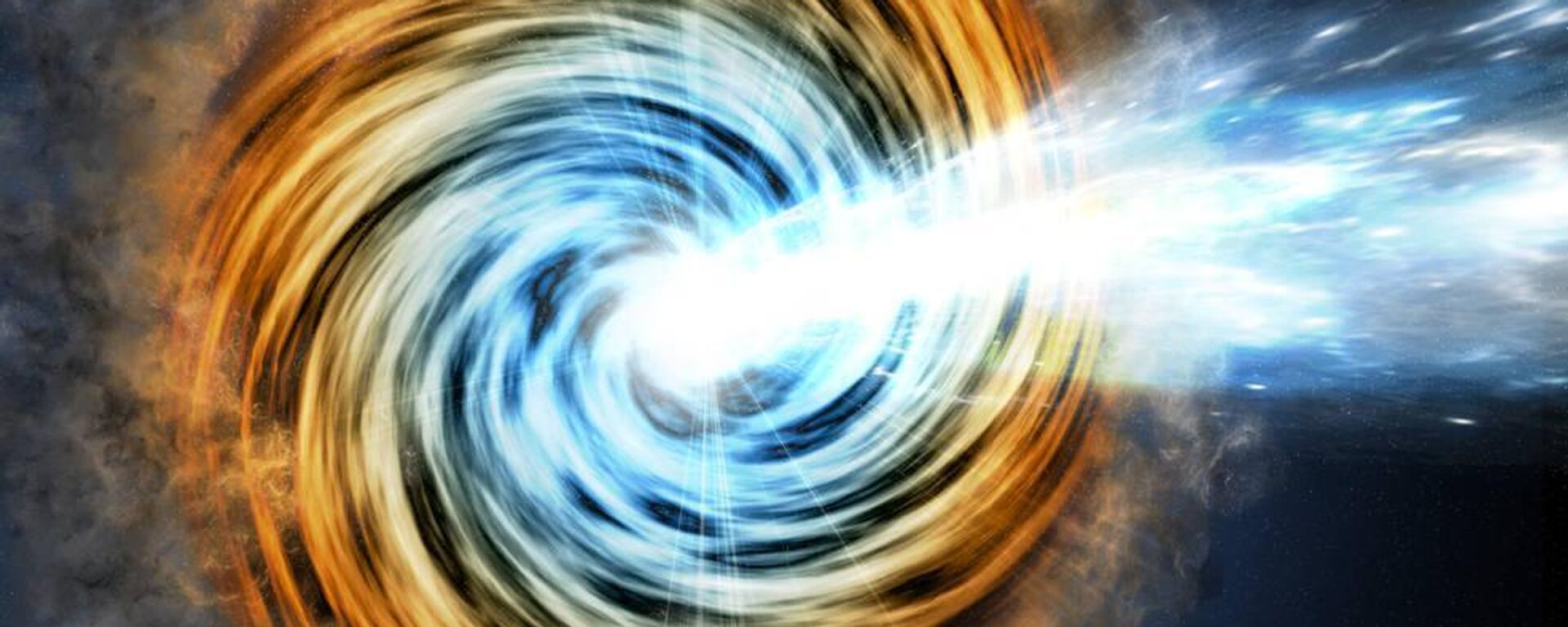https://sputnikglobe.com/20231019/cosmic-scales-ancient-fast-radio-wave-burst-could-be-used-to-find-universes-weight-1114338608.html
Cosmic Scales? Ancient Fast Radio Wave Burst Could Be Used to Find Universe’s Weight
Cosmic Scales? Ancient Fast Radio Wave Burst Could Be Used to Find Universe’s Weight
Sputnik International
Astrophysicists have struggled to understand just how much matter there is in the universe, leading to hypotheses about the existence of “dark matter” that we cannot observe aside from the gravitational effect it has on matter.
2023-10-19T21:10+0000
2023-10-19T21:10+0000
2023-10-19T21:10+0000
beyond politics
astronomy
fast radio burst (frb)
neutron star
magnetar
mass
universe
https://cdn1.img.sputnikglobe.com/img/07e6/02/1a/1093381246_0:0:1281:721_1920x0_80_0_0_26a522d00402f8f13c05ce7b478b2d9a.jpg
A powerful, ancient radio signal recently discovered by astronomers could be the key to detecting intergalactic matter, a group of scientists argued in a paper published in Science on Thursday."If we count up the amount of normal matter in the Universe - the atoms that we are all made of - we find that more than half of what should be there today is missing," study co-lead author Ryan Shannon, a professor of astrophysics at Swinburne University in Australia, said in a statement.The key is FRB 20220610A, a fast radio burst (FRB) that originated 8 billion years ago from the heart of three merging galaxies. It’s considerably more distant than the previously known most distant FRB source and was enormously powerful, releasing more energy in one millisecond than the sun does in 30 years.Fast radio bursts are not well-understood phenomena. First detected in 2007, FRBs are believed to be connected to magnetars, a type of neutron star with a hugely powerful magnetic field, of which only a handful have ever been found. However, other sources have not been ruled out, and the mechanism that causes FRBs is unknown. Other suggested sources include collisions between very dense objects such as black holes or neutron stars; supernovas, and even extraterrestrial intelligence.Most FRBs are single-episode events, lasting a few seconds at most and constituting a single powerful blast of radio waves. However, some FRBs repeat on regular cycles, adding to astronomers’ confusion.SKAO Postdoctoral Fellow Hao Qiu explained that as the FRB moves through intergalactic space, it interacts with the matter there, allowing us to observe it from Earth.“Optical observations play a complementary role by enabling us to identify the distance of the host galaxy and learn more about the host and foreground environment along the line of sight. Comparing the radio and optical data allows us to test cosmological models of the intergalactic medium and better understand what could create these bursts.”
https://sputnikglobe.com/20231006/hubble-discovery-of-new-fast-blue-optical-transient-poses-more-questions-than-it-answers-1113991988.html
Sputnik International
feedback@sputniknews.com
+74956456601
MIA „Rossiya Segodnya“
2023
News
en_EN
Sputnik International
feedback@sputniknews.com
+74956456601
MIA „Rossiya Segodnya“
Sputnik International
feedback@sputniknews.com
+74956456601
MIA „Rossiya Segodnya“
fast radio burst; frb; intergalactic; astronomy; magnetar
fast radio burst; frb; intergalactic; astronomy; magnetar
Cosmic Scales? Ancient Fast Radio Wave Burst Could Be Used to Find Universe’s Weight
Astrophysicists have struggled to understand just how much matter there is in the universe, leading to hypotheses about the existence of “dark matter” that we cannot observe aside from the gravitational effect it has on other matter.
A powerful, ancient radio signal recently discovered by astronomers could be the key to detecting intergalactic matter, a group of scientists argued in
a paper published in Science on Thursday.
"If we count up the amount of normal matter in the Universe - the atoms that we are all made of - we find that more than half of what should be there today is missing," study co-lead author Ryan Shannon, a professor of astrophysics at Swinburne University in Australia,
said in a statement.
"We think that the missing matter is hiding in the space between galaxies, but it may just be so hot and diffuse that it's impossible to see using normal techniques,” he explained.
The key is FRB 20220610A, a fast radio burst (FRB) that originated 8 billion years ago from the heart of three merging galaxies. It’s considerably more distant than the previously known most distant FRB source and was enormously powerful, releasing more energy in one millisecond than the sun does in 30 years.
The discovery was made using the ASKAP radio telescope in Western Australia and the European Southern Observatory’s Very Large Telescope (VLT) in Chile, while the Keck Observatory in Hawaii obtained direct images of the burst’s galaxy of origin at other wavelengths.
Fast radio bursts are not well-understood phenomena. First detected in 2007, FRBs are believed to be connected to magnetars,
a type of neutron star with a hugely powerful magnetic field, of which only a handful have ever been found. However, other sources have not been ruled out, and the mechanism that causes FRBs is unknown.
Other
suggested sources include collisions between very dense objects such as black holes or neutron stars; supernovas, and even extraterrestrial intelligence.

6 October 2023, 20:30 GMT
Most FRBs are single-episode events, lasting a few seconds at most and constituting a single powerful blast of radio waves. However, some FRBs repeat on regular cycles, adding to astronomers’ confusion.
SKAO Postdoctoral Fellow Hao Qiu explained that as the FRB moves through intergalactic space, it interacts with the matter there, allowing us to observe it from Earth.
“Radio observations give us key information that allows us to measure the turbulent magnetized interstellar and intergalactic medium between us and the host galaxy,” Qui said.
“Optical observations play a complementary role by enabling us to identify the distance of the host galaxy and learn more about the host and foreground environment along the line of sight. Comparing the radio and optical data allows us to test cosmological models of the intergalactic medium and better understand what could create these bursts.”



